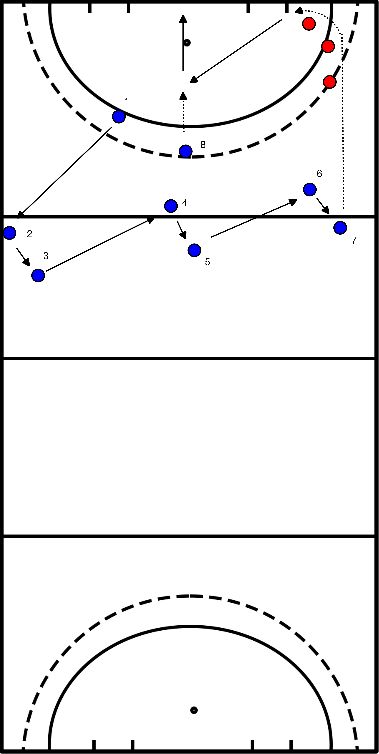Hockey drills for technique warming-up
- Two pairs shake hands in a crossed position (see photo) and kneel down in the sitting position.
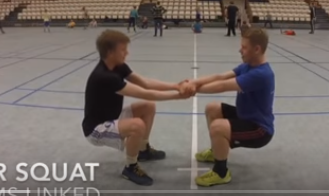
- 2 opposite each other, bend their knees in the sitting position and come up and kick forward with the left and right leg alternately.
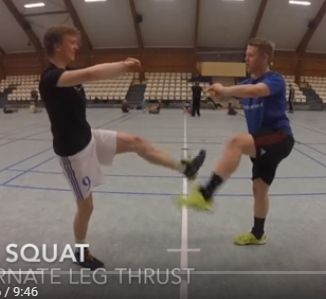
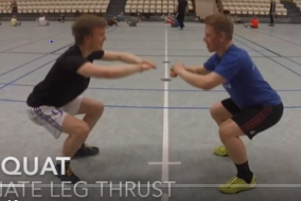
- 2 pawns face each other,
- at a random distance (depends on whether you want to push or flatten, for example).
- Player 1 and 3 stand with pawn A.
- Player 2 stands at pawn B.
- 1 plays the ball to player 2,
- 2 receives the ball.
- After player 1 passes the ball, he runs after his ball towards pion B.
- When player 2 has passed again he runs in the direction of pion A.
- etc. etcde
- You can play this exercise with minimum 3 players, maximum 5 otherwise the intensity will be very low.
- Players divided into two groups on one side of the field.
- Two rows of cones next to each other.
- Players pass the ball back and forth while walking past the cones.
- Variations
- Individuals keep ball high along a row of cones, both groups independent of each other.
- Passing the ball two by two
- Individually dribble two balls at the same time, slalom through the cones
- Pass the ball and dribble a second ball at the same time (player says yes).
- Three of you play over 2 balls to the other side.
Goal
- To regain that ball feeling and get back into the swing of things.
Set up
- The players form pairs
- and they stand opposite each other on a few meters (5 for example).
- Then they start pushing each other.
- At a certain moment, they take some more distance and start flattening.
Start with a three-run.
- A floats with the ball, when A is halfway, he pushes the ball out of the run to B.
- B does the same (to C)
- etc.
- Apply differentiation.
Possibly after this warm-up play another game of possession.
Purpose
: To get warm through a combination of passing, running, and picking up in the run and from standstill.
Format
:This exercise is also known from volleyball. The pawns are not exactly in a triangle. It is possible, depending on the number of players, to set up a multiple of the exercise.
- The player at A passes the ball straight to the player at B.
- The player at B plays the ball to the player at C and runs towards point A.
- The player at C receives the ball at point D and passes it to point A.
- For the changeover, A runs to B, B via D to C and C to A.

Variations:
- Variations can be made in terms of stroke. (hit, push, flats)
- The distances can be made larger or smaller to adjust the level of difficulty.
- Pawns can be placed to play in between. This is to increase the purity. When you make the cones smaller, the degree of difficulty increases.
- To play the ball from C to D there can be bounced.
- To play the ball from D to A you can play bounce.
- You can also place point C on the other side so that you reverse backhand and forehand.
- When you place point C at 90 degrees from point B, you can do the same exercise, only then you will hit point D from a different angle.
- When you set up different situations, you can rotate the exercise. Situation A is the standard, in situation B the exercise is mirrored, in situation C the exercise is set up so that point B and C are at 90 degrees from each other and situation D is a mirror of situation C.
Points of attention:
- As a trainer you can take a good look at the different techniques of your players.
- Sit low at the take-off.
- When playing the ball from C to D, the ball may not shoot too far in the direction of A. The intention is that the player coming from B should take the ball at right angles.
- Play the ball on the forehand where possible.
- Stand ready to receive the ball. (low to the ground, stick on the ground)
Purpose
: Various technical forms to warm up.
Format
:The exercise can be set up one-sided or two-sided. This depends on the number of players in the training.
- At point A, the player makes a drag and passes the pawns. Then he passes to the player at point B.
- The player at point B takes the ball and dribbles to point C. From there he passes to the player at point C.
- The player receives the ball and turns towards the goal, completing the pass
- Before turning, you run after the ball. Point D rejoins point A again.
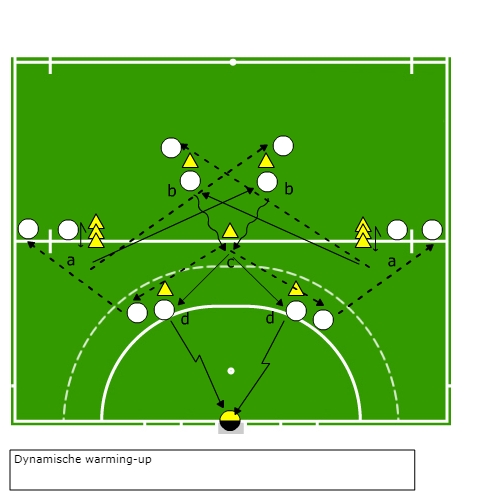
Variations:
- You can set up the exercise single-sided and double-sided.
- You can also choose to warm up the goalkeeper in this way.
- At C, you can switch sides. If you are coming from the right, play the ball to the right, so that you can practise from both sides.
Points of attention:
- This is a good time to look at different techniques of your players and polish them.
- When turning and dribbling, the ball must stay on the stick.
- There is only one point at C, so players should not get in each other's way and look for the next ball to enter play.
- All balls are played into the forehand of the teammates.
- Jump where you stand:
- Stand with your feet shoulder-width apart.
- Concentrate on a point on the floor and hop up and down where you stand.
- Jump sideways:
- Stand up straight, keep your hands in front of you and jump from side to side.
- Butt Kicks:
- Stand up straight, and keep running in your place as you lift your heel up and touch your buttocks with every step.
- High stepping:
- Lift the leg with the knee at a 90 degree angle.
- Quickly alternate with the other leg.
- Standing bike crunches:
- Stand with your feet apart at shoulder width.
- Bring your knee to your opposite elbow.
- Go back to the starting position and repeat with the other side (belly / legs).
- Sumo squat:
- Stand with your feet 6-12 cm apart.
- Stretch out your arms in front of you.
- Lower your body until your thighs are parallel to the floor.
- Return to the starting position and repeat the exercise (legs / buttocks).
- Jumping without a rope:
- Hold your arms along your side and pretend to hold the end of a jump rope in each hand.
- Jump up and come down alternately on the ball of each foot, while simultaneously twisting your wrists as if you were letting a rope go around.
- Jumping without a rope:
- Hold your arms along your side and pretend to be holding the end of a skipping rope in each hand.
- Jump up with 2 feet, while at the same time twisting your wrists as if you were making a rope go around.
- Arm Swings clockwise:
- Stand on the ground with your arms straight outstretched to the side at shoulder height.
- Move your arms quickly in large circles clockwise (arms).
- Arm Swings counterclockwise:
- Stand on the ground with your arms straight outstretched to the side at shoulder height.
- Move your arms quickly in large circles counterclockwise (arms)
- Toy soldiers:
- Start with your feet at shoulder width apart. Keep your legs and arms stretched.
- Kick up your left leg until your right hand touches your toes.
- Repeat with the other side (belly / legs / arm / shoulder).
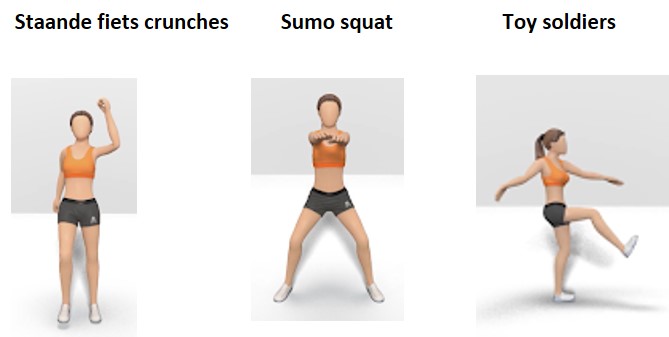
- Players outside the box should replay as often as possible.
- The pass must always pass through the box.
- The players inside the box must try to intercept the ball.
- As soon as the players inside the box have intercepted the ball, they should replay as often as possible inside the box.
- Each time they have replayed 3 times, someone outside the box may enter the box to recapture the ball.
- As soon as they succeed, they will play to someone outside the box and it will start over again, so at least one player must always remain outside the box to be able to play.
- The field can be larger or smaller, there can be more or less players inside and outside the box.
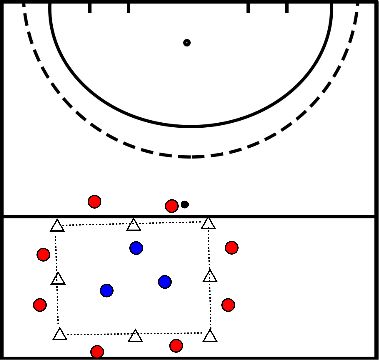
Make 2 teams.
- Both teams have their 'own' course, where they can score points (for example by playing over 5 times in their own course).
- The other team is allowed to conquer the ball in the other box, but not everyone from the other team is allowed to enter the other box.
- The number of players of the other team -1.
- As soon as blue has captured the ball, blue will go to his own square as soon as possible and will play over there as often as possible.
- There may be 3 players of red in the blue box.
- See example: in team red there are 4 players, so 3 players of blue are allowed to enter the red box.
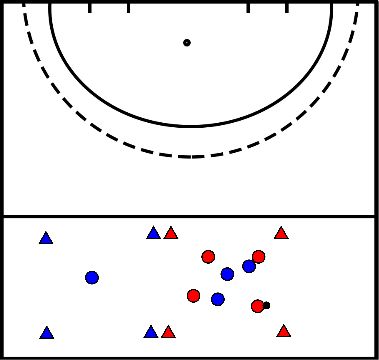
- Goal: to show the player when it is best to pass and when it is best to push.
- In case of a long pass you pass, in case of a short pass you push.
- Player 1 passes (long pass) the ball to player 2
- Player 2 pushes (short pass) the ball to player 3.
- Player 3 passes (long pass) the ball to player 4.
- Player 4 pushes (short pass) the ball to player 5.
- Player 5 passes (long pass) the ball to player 6.
- Player 6 pushes (short pass) the ball to player 7.
- Player 7 runs along the red pilons to the back line and passes (long pass) the ball to player 8, who has entered the circle.
- When explaining the exercise, you can let the player fill in whether it's a long or short pass and what kind of stroke you use, this way they will actively think about it and will apply it earlier in the game.
